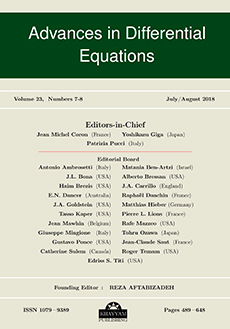Abstract
We are investigating regularity issues for parabolic almost minimizers of integral functionals with polynomial growth structure. In particular, we are interested in functions with values in the target space $\mathbb R^N$ for a dimension $N > 1$ and our aim is to prove Hölder continuity for the spatial gradient of an almost minimizer on an open set of full Lebesgue measure. As classical counter examples show, the regularity results which we achieve are optimal if we are dealing with general almost minimizers and dimensions of the target space strictly greater than one. However, the results are also valid in the case $N=1$, even if they are not optimal in that case. Our contribution can be seen as a natural generalization of the elliptic regularity theory for the gradient of vector--valued almost minimizers, which was developed in the 1980s to the framework of time-dependent, parabolic, problems. The parabolic nature of the problem, in combination with the fact that almost minimizers, in general, do not satisfy any associated parabolic partial differential equation, causes a variety of difficulties in regularity theory, which have to be overcome. The first part of the paper covers integral functionals, which involve merely the spatial gradient of the almost minimizing function. In this case, we obtain a partial Hölder regularity result for the spatial gradient with a Hölder exponent, which can be determined in a quantified way in dependence of the data of the problem. In the second part, we develop the theory for integrands, which involve not only the spatial gradient, but also the almost minimizer itself. In this more general case, the proof becomes substantially more involved, since a priori higher integrability of the spatial gradient has to be used. As a consequence, the explicit control on the Hölder continuity exponent gets lost. This is also in accordance with the elliptic theory where the same phenomenon occurs.
Citation
Jens Habermann. "Vector--valued parabolic $\omega$--minimizers." Adv. Differential Equations 19 (11/12) 1067 - 1136, November/December 2014. https://doi.org/10.57262/ade/1408367289
Information





